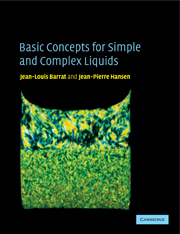1 - An introduction to liquid matter
Published online by Cambridge University Press: 06 January 2010
Summary
One of the most remarkable observations in physical sciences or, for that matter, of everyday life, is that most substances, with a well defined chemical composition, can exist in one of several states, exhibiting very different physical properties on the macroscopic scale; moreover one can transform the substance from one state (or phase) to another, simply by varying thermodynamic conditions, like temperature or pressure. In other words, a collection of N molecules, where N is typically of the order of Avogadro's number NA, will spontaneously assemble into macroscopic states of different symmetry and physical behaviour, depending on a limited number of thermodynamic parameters. The most common states are either solid or fluid in character, and are characterized by qualitatively different responses to an applied stress. At ambient temperatures, the solid states of matter are generally associated with the mineral world, while ‘soft’ matter, and in particular the liquid state, are more intimately related to life sciences. In fact it is generally accepted that life took its origin in the primordial oceans, thus underlining the importance of a full quantitative understanding of liquids. However, even for the simplest substances, there are at least two different fluid states, namely a low density ‘volatile’ gas (or vapour) phase, which condenses into a liquid phase of much higher density upon compression or cooling. For more complex substances, generally made up of highly anisotropic molecules or of flexible macromolecules, the liquid state itself exhibits a rich variety of structures and phases, often referred to as ‘complex fluids’.
- Type
- Chapter
- Information
- Basic Concepts for Simple and Complex Liquids , pp. 1 - 35Publisher: Cambridge University PressPrint publication year: 2003



